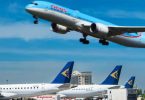Thailand international carriers, Thai Airways International and Bangkok Airways, both experienced harsh times in 2009. This situation was due not just because of the recession but also because of an instable political situation. And both are now revamping their strategies to strengthen their position internationally.
Thai Airways’ 50th anniversary is seen as an opportunity for the airline’s management to completey review business practices at the airline. For Pruet Boobhakam, vice president of sales, Thai Airways must fight back to enhance all products on board and its service standards, as well as its business ethics. “We look now at a new model for growth where we are focusing on constant quality at all levels, with our primary concern being passengers’ satisfaction. We want to be the best airline in Asia and not only being in third or fifth position,” he said.
Ethic-driven business will probably be the most difficult to implement, as Thai is plagued with an entrenched tradition of nepotism. Many politicians are used to seeing the national carrier as their own airline with a high number of dignitaries and Thai Airways executives benefiting from free flights and other perks for their entire life – a situation that Thai Airways’ management is now keen to change. A similar fight is to be expected with unions protecting its older inefficient flight attendants. They generally come from wealthy Thai families and look more to their future shopping spree in London or Paris than at serving passengers when they are on duty.
The first commercial measure includes the improvement of Internet sales channels. “Our online sales reached last year 6 percent, in line with our forecast. For this year, we target 15 percent of online sales, with a future target of 25 percent to 30 percent,” said Boobhakam. By May, Thai Airways will introduce a new booking engine, which will give further flexibility to passengers. They will then be able to book according to fare levels, a practice already in use with Lufthansa, SAS, and Singapore Airlines.
Looking at the service on board, Thai Airways will refit all its classes. “It is urgent for us to modernize our economy class in our long-haul network and provide a consistent standard of service on all aircraft, even older models such as the Boeing 747-400,” highlighted Boobhakam. Economy class will consequently be refurbished with new seats and individual videos. “Our current business class and first class are still competitive. We will then adapt some of the features before launching brand-new products once our fleet [is] renewed,” added the vice president. This year, Thai Airways will put into service a new Airbus A380, with delivery expected for 2012/13. “We will then bring our premium classes to the highest most modern standards,” he promised.
In between, the airline will improve its on-board menus, integrating more local specialties in all classes and improving service training for flight attendants to make them more responsive. From a strategic point of view, the airlines looks, with its partners of Star Alliance, to further strengthen Bangkok as a major Asian hub. “We have three waves of departure in a day, which ideally connects most of our flights. We will adjust some of the departures, but it will be difficult to further boost the connectivity through additional waves of flights as Intercontinental flights depart mainly at night and arrive mainly in the morning. However, we could offer a mini-wave to connect regional destinations,” said Boobhakam. According to the vice president, increasing code-share flights will help Thai Airways to become more global. “With Johannesburg being back in our network, we look at code-sharing with Star Alliance partners to South America. We are also working with All Nippon Airways in Tokyo to offer flights from Bangkok to Honolulu and look as well to expand our presence in Chicago, New York, and Canada,” he said.
Domestically and regionally, Thai Airways looks also to develop a two-brand concept, thanks to the integration of Nok Air into Thai Airways general strategy. “Nok Air’s lower costs can help us to maintain a Thai Airways presence in important markets with lower profitability such as Penang. A lot will depend about Thai Airways being approved to increase its shares into our low cost subsidiary,” explained Boobhakam.
The vice president of sales remains optimistic that all these new measures will make Thai Airways again a leading carrier in southeast Asia. “We are profitable again, including on our domestic network where we traditionally used to lose money. Our yields are up from 1.85 to2.26 Baht in Revenue Passenger-Kilometers. We reached our highest load factor in cabin in our history last January at 82.4 percent,” added Pruet Boobhakam.
(eTN): Thai Airways International on the path to recovery | re-post license | post content






















